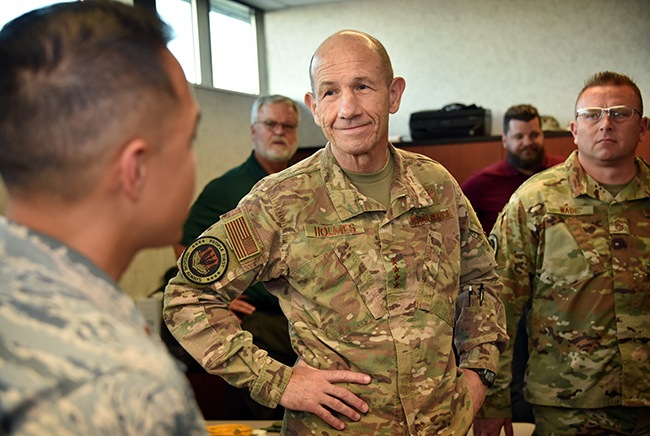
Air Combat Command chief Gen. Mike Holmes visits with airmen in the Cyber Field Training Unit at the Combat Readiness Training Center in Savannah, Ga., on June 26, 2019. Air National Guard photo by Amber Williams.
The long-planned merger of 24th and 25th Air Forces into a new information-warfare organization won’t happen until this fall, as its portfolio expands to cover weather specialists and several other activities, Air Combat Command chief Gen. Mike Holmes said.
“We’ll start off with consolidating a component [numbered Air Force] with an integrated staff and a single operations center that ties those things together,” Holmes said at an Aug. 23 AFA breakfast in Arlington, Va. “We can do that at [initial operational capability] this fall.”
The Air Force said in April it would stand up the united group in a ceremony in late summer.
The new organization was initially envisioned to combine intelligence, surveillance, reconnaissance, cyber, electronic warfare, cryptography, and related fields and refine how all work together. But Holmes acknowledged the service is still working out how to operate in the “information spectrum” and what that should encompass.
“We’re going to move the 557th Weather Wing over in alignment with this NAF,” he said. “When you think about what our weather wing does, it takes information, gathered by sensors all over the world, it uses algorithms and people to work through it, and provides it out through networks. So, it kind of fits in with our ISR and cyber missions, and we think it’ll have a better home there.”
The 557 WW was created from the Air Force Weather Agency in 2015 and falls under Air Forces Southern under Air Combat Command.
The NAF commander will serve as the Air Force’s service component within US Cyber Command, Holmes noted. One commander will oversee all of the Air Force’s new cyber mission force teams within the merged organization as well.
The NAF commander will also lead a “Joint Force Headquarters Cyber/Air Force” focused on US European Command, US Transportation Command, and US Strategic Command, Holmes said. That same person is expected to run all Air Force-provided networks, from the unclassified level to higher, more secret levels.
“He’ll be our service cryptological component commander, working in support of any airmen that we provide to the National Security Agency and the other things we do across the intelligence community,” Holmes added.
The organization will be based at JB San Antonio-Lackland, Texas, though the service has not yet announced its official title. Air Force Magazine previously reported that officials at Offutt AFB, Neb., believe their base could serve as a major information warfare hub as well.
Each service defines information warfare differently. For the Air Force, Holmes said, it boils down to the central issue of “how do we take all that data that’s out there, available to us, and use tools to make that data work on behalf of warfighters”
That’s not to be confused with information operations, he said: “a little more tailored; precise intelligence information, crafting a message that will have the right impact, finding the right audience to deliver it to, and have the means to deliver it to them, to derive an effect.”
The forthcoming NAF aims to build on Air Forces Cyber’s work in that area as the service looks to deter bad actors in the digital sphere.
“We’re in a competition with peer adversaries, that has a military component that largely stays below the level of armed conflict, and we’d like to keep it there,” Holmes said.
The Air Force wants to recast the competition “in terms that are favorable for us” and add new data-driven options for national leaders that help rebuff “malign activities at all levels from that information warfare level all the way up to major conflict,” he continued.
The new NAF is also poised to play a key role in planning for future military activity in the electromagnetic spectrum, as the Air Force looks to rebuild those capabilities after 15 years of focusing on violent extremism. Holmes envisions the branch could oversee rapid analysis of sophisticated EW threats and counter them in near-real time.